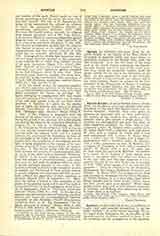

Apostle Spoons. —A set of thirteen spoons, usually silver, the handles of which are adorned with representations of Our Lord (the Master spoon) and the twelve Apostles. Anciently they were given by sponsors as baptismal gifts to their godchildren, the wealthy giving complete sets, others a smaller number, and a poor person a single spoon. The Apostles are distinguished one from the other by their respective emblems: St. Peter with a key, sometimes a fish; St. Andrew with a saltire cross; St. James Major with a pilgrim’s staff and gourd; St. John with a chalice; St. Philip with a long staff surmounted with a cross; St. James Minor with a fuller’s bat; St. Thomas with a spear; St. Bartholomew with a butcher’s knife; St. Matthew with a wallet, sometimes an axe; St. Matthias with a halbert; St. Thaddeus, or Jude, with a carpenter’s square; St. Simon with a saw. In some sets St. Paul takes the place of St. Matthias; his emblem is a sword. It is doubtful if these spoons were much in use before 1500; the oldest one known is of the year 1593, and they first appeared as a bequest in the will of one Amy Brent who bequeathed in 1516 “XIII sylver spones of J’ hu and the XII Apostells”. They are alluded to by the dramatists, Shakespeare, Ben Jomson, Middleton, Beaumont, and Fletcher. In Henry VIII, Act 5, Scene 3, the King asks Cranmer to be sponsor for the infant Elizabeth; he demurs because he is a poor man, upon which Henry banters him in these words: “Come, come, my lord, you’d spare your spoons.” While these apostle spoons were used on the Continent, especially in Germany and Holland, they were never as much in vogue there as in England.
CARYL COLEMAN

